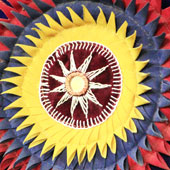Design Resource
Applique crafts
The Craft of Motifs on Textiles
by
Process - Pipli Applique Work

The specially prepared motifs may be coloured or white. The base cloth is usually coloured. Some of the specially prepared motifs have exclusive embroidery work and some have mirror work. In heavy canopies, a backcloth for strength additionally supports the base cloth. Appliqué items are also being used in combination with other handicrafts to produce composite products.
• Stitching Process
The stitching process varies from item to item and come under six broad categories
Namely:
1. Bakhia: It is a simple running stitch which is used either for keeping the patches in position temporarily on the base cloth till they are finally stitched to it.
2.Taropa: Under the stitching process the appliqué patches are stitched with the base cloth where the edges of the patches are turned in and then stitched. In the process the stitch is almost concealed underneath the patch.
3.Ganthi: The Ganthi stitch that is similar to blanket stitch and buttonhole stitch is used for attractive embroidered motifs.
4.Chikana: The chikana stitch that is also called chain stitch is popular in appliqué work. It is an embroidery stitch built up by looping of threads and is used in binding the edges of the appliqué patch without turning, as well as for making textual and ornamental effects on motifs.
5.Button hole: The buttonhole stitch is used for mudias (rings) fixed to large canopies for hanging and for fixing round-shaped small mirrors pieces for decoration. It is similar to blanket stitch although the needle is inserted form outer edge in this stitch.
6.Ruching: The ruching stitch is used for gathering a strip of cloth to make an appliqué motif like malli.







